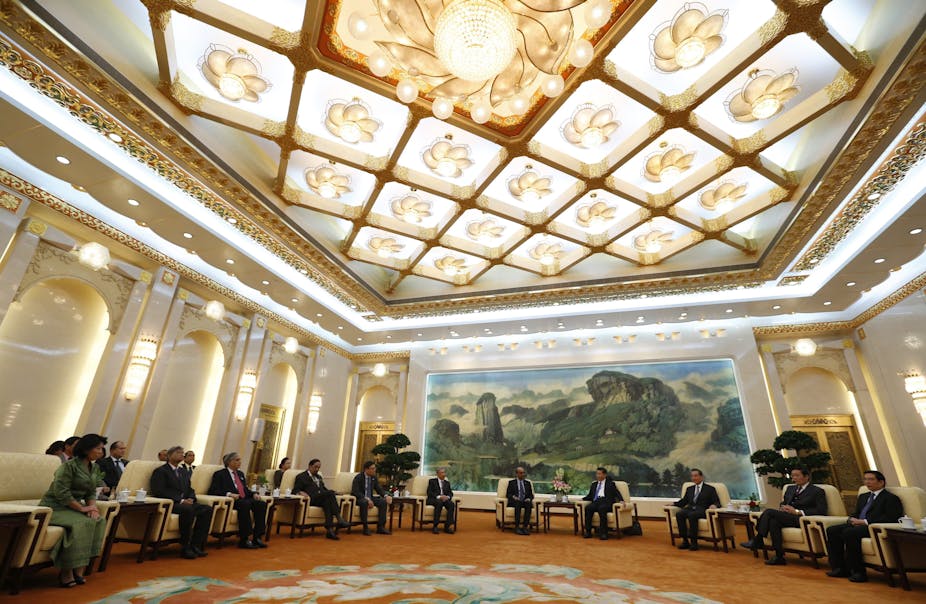At the end of this month, a new development bank will have arrived, the Asian Infrastructure Investment Bank, with close to 30 founding members. It will be housed in Beijing, predominantly financed by China, and will have a governance structure that reflects the GDP of each participating country.
Now that the UK and New Zealand have joined as founding members, there is no real political impediment left to Australia joining up. Our treasurer, Joe Hockey is warming up to the idea, with no conspicuous dissenters. The prospect of being able to influence how US$50-100 billion of mainly Chinese money gets spent in the region will probably entice Australia to sign up as a founding country before the deadline at the end of this month.
We of course shouldn’t expect to have much say in this bank. Since voting rights will be according to the GDP of each participating country, and Australia representing roughly 2% of world GDP, we won’t have much influence and will mainly have to watch others decide on things. Since we seem unlikely to put in substantial amounts of money, given the large deficit the government now runs, we will have very little skin in the game to lose.
An embryonic bank
We don’t really know what the new development bank will do. The Chinese have been pushing this bank as an alternative to the US-EU dominated World Bank and IMF, as well as the Japan-dominated Asian Development Bank, which the Chinese see as doing the bidding of those powers. They have promised to put up 50% of the US$50 billion initial capital of the new bank, with an option to increase the “authorised” amount of capital to $US100 billion.
The intention seems to be to fund large infrastructure projects in the Asian region, including the new Silk Road through Central Asia and new ports and (rail)roads throughout the Asian region. Yet, $50 billion is only a drop in the ocean compared to national government budgets and infrastructure needs, so the bank would have to become much bigger to deliver a lasting impression on the region.
We also don’t know how funds will be allocated: those “details” are yet to be decided. The Chinese have promised a lean and fast lending process, hence without the checks-and-balances that make the World Bank and the Asian Development Bank notoriously slow and difficult. The flip-side of that coin is that they are not going to look too closely at whether the money is spent wisely or whether dictators will pocket some of it themselves. It is hoped that a large board of governors will steer things in a good direction, but there’s no guarantee.
One main reason for China to set up a new development bank is that they were kept from the decision-making tables at the other development banks: despite being of roughly equal size now to the US, their voting rights in the IMF are about one third of that of the US, and their say in the Asian Development Bank is similarly paltry. Probably believing that the ability to lend helps with political influence over countries, they decided to put up their own bank, in which the voting rights would reflect economic size more directly.
The decision by China to put GDP up as the measure of influence in this new institution was somewhat surprising. This will favour China for some time but may come back to haunt it when India (which is also a founding member) really becomes big. It will certainly lead to additional pressure on the “proper” measurement of GDP.
How influential will the bank be?
In terms of size, this is a small bank to begin with. Compared to the size of big commercial banks, the new bank will be puny: the top four banks in China have combined assets of around US$11 trillion, compared to which the new bank is a non-entity. It will also be small compared with other development banks. The International Bank for Reconstruction and Development, which is part of the World Bank Group, has an asset base of US$360 billion, with around US$230 billion of “subscribed” capital, lending out up to US$20 billion a year. The Asian Development Bank lends out some US$13 billion a year. Unless the new bank increases dramatically in size, it will be smaller than either.
Its effect on the region will be to make loans cheaper, particularly if the bank is ramped up in size. This will have overspill effects on loans in the whole world, much like cheap Chinese loans helped fund the spending bubble in the US before the global financial crisis. There is an inevitability about this though: the Chinese now have trillions of dollars in surplus money earned via a huge trade surplus, and they are going to lend it out cheaply one way or another. World interest rates will be low for some time to come.
Why join?
All in all, I think it is a good idea for Australia to join: we have little reason to stay out, and getting a seat at the table early on means we, potentially together with the other Anglo-Saxon countries involved, will have some say in how it operates. We won’t get any money out of it ourselves, since the bank is expressly oriented towards infrastructure in Asia, but perhaps our involvement might persuade the Chinese government that it can do business with the Australian government and that we are a place to give cheap loans to in the future.
What is an unknown is how this will fit in with the vaunted G20 plan to have a global infrastructure fund, potentially based in Australia. For one, the G20 talked about trillions, orders of magnitude bigger than the AIIB. Also, the new bank will only invest in Asia. So by the looks of it, this new bank has little to do with the G20 pronouncement.

